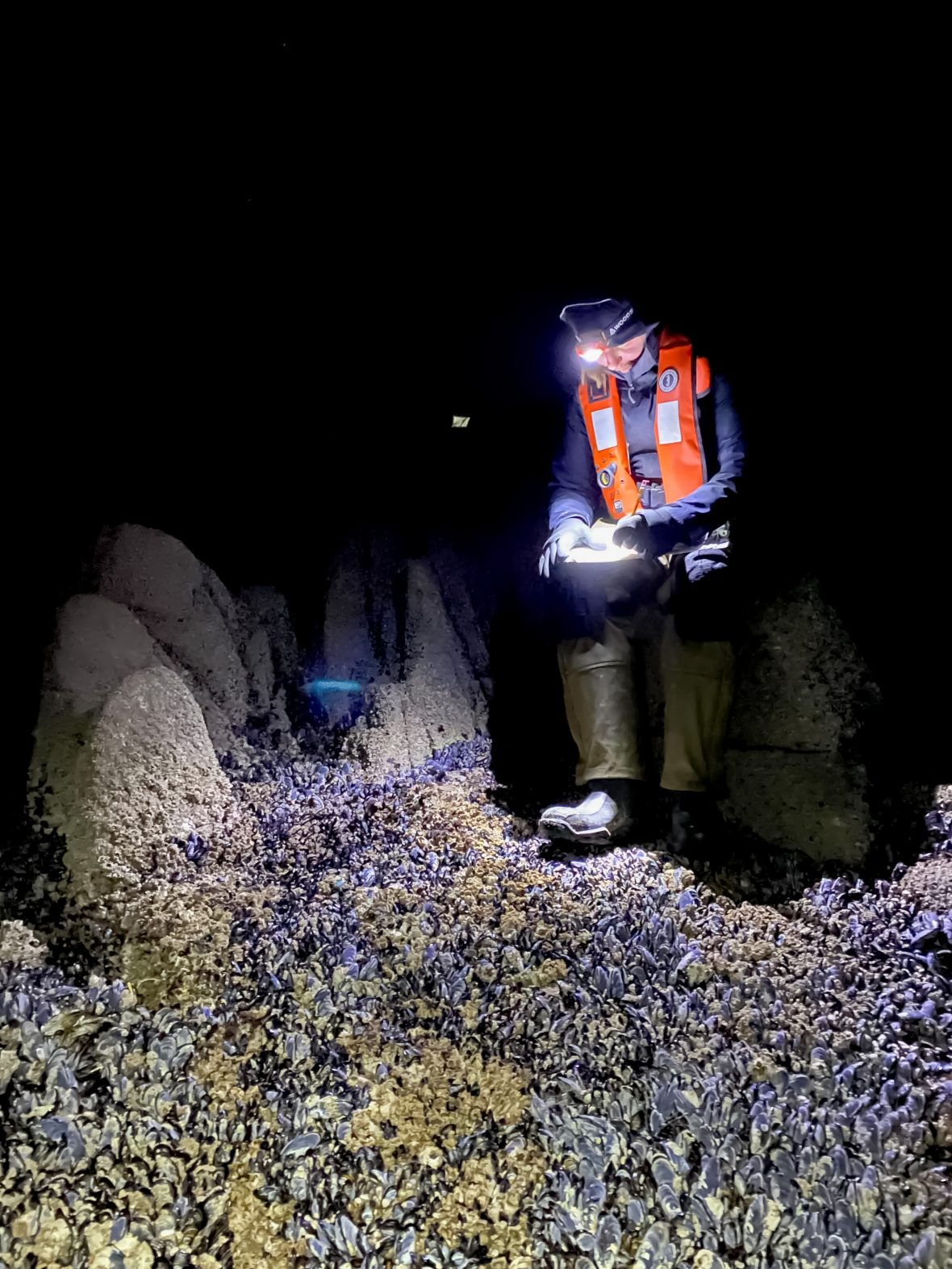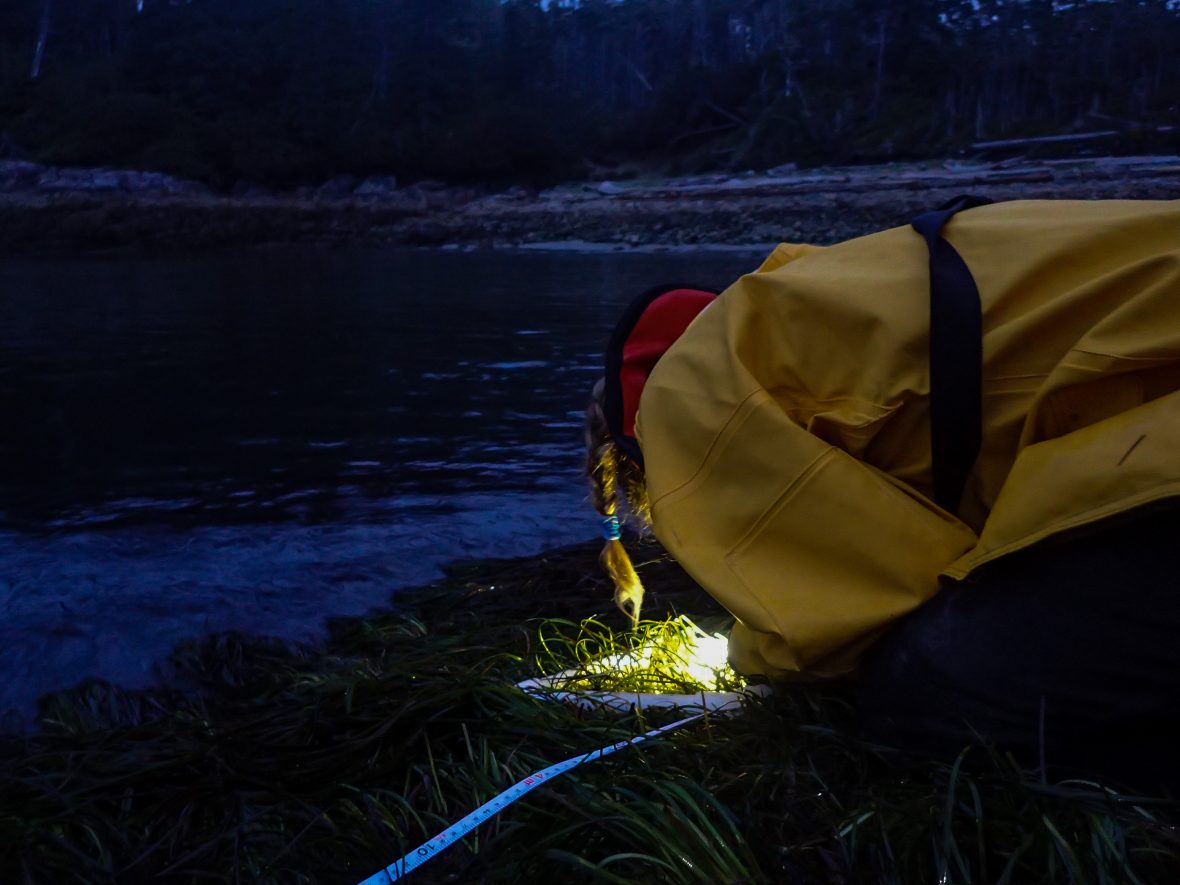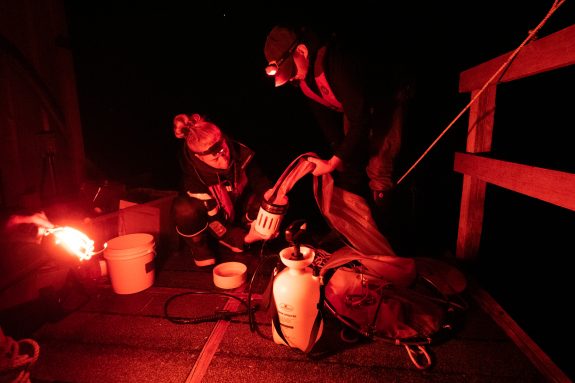Science After Dark
Whether due to the timing of tides or the daily cycles of plankton, some research groups find themselves surveying life in the dead of night.
Dots of light bob up and down and illuminate puffs of breath as a few people fan out across the rocky shoreline. They’re searching for markers—the flash of neon-colored zip ties and the glint of steel bolts that signify the edge of a monitoring site. It’s midnight and temperatures have dipped—but for a handful of hardy Hakai Institute research technicians, work is just getting started.
It takes a certain amount of grit to get the data in the first place. It’s winter on the wave-swept western shores of Calvert Island, and one intrepid team is looking for invertebrates in the intertidal. It’s a task usually tackled during the lowest tides of the year, so when these lows happen long after the sun has gone down—as they tend to do in winter—you bundle up, pack multiple headlamps and plenty of spare batteries, and head out into the dark.
“Winter fieldwork can bring a trifecta of discomfort—dark, cold, and past your bedtime,” says research technician Gillian Sadlier-Brown.
The cold reached its lowest one February evening when an Arctic outflow delivered windchill temperatures of -20 °C. “That was pretty memorable,” says research technician Tyrel Froese. “I think that was about as cold as it gets.” The team called off their quest for chitons when the seagrass where they were searching broke off in their hands, frozen solid.
While that level of chill is rare, the darkness is ubiquitous. “Visibility is the biggest challenge—being able to see the whole site, see where you’re going, where your plots are. So it’s going more slowly, making sure you’re not missing anything,” says Froese.


First photo: Tyrel Froese surveys invertebrates found on mussel beds by the light of a headlamp, a process he describes as a balance between being careful and thorough while keeping an eye on the tide level. “You’re racing the tide the whole time.” Second photo: Gillian Sadlier-Brown surveys a seagrass bed before dawn. Photos by Alyssa Gehman
When searching for camouflaged critters in the dark, a good headlamp is worth its weight in gold—and, counterintuitively, may even help in the hunt. “It helps you zero in on your field of view,” says Sadlier-Brown. “You don’t really need to see beyond your headlamp.”
“Most of our surveys require getting right up to the rock,” adds Froese. “You’re right down in the mussel beds with this big spotlight on your head, and you start seeing little things between the mussels that you might not necessarily have seen in the bright light of day.”
Thankfully, despite the discomforts there’s payoff in the form of interesting finds. When the tide recedes during the day, it exposes intertidal life to both the heat of the sun and to the keen eyes of potential predators, so more mobile creatures like crabs and worms stay hidden. But under cover of darkness, different animals become active.

“It’s rare to have lots of long-term data sets that have year-round sampling,” says Hakai Institute marine ecologist Alyssa Gehman. This is in part because such data is often gathered by graduate students doing fieldwork in the summer. Collecting throughout the year tends to be more logistically difficult—particularly at these latitudes, where nighttime low tides are a more common occurrence, and where winter conditions are tough. “Hakai’s flexibility [in planning] is why we can do this. We are one of the few organizations that can pull it off.”
It’s not just in winter that Hakai researchers go out at all hours of the night. In July, a couple hundred kilometers to the south on Quadra Island, another team collects light-sensitive zooplankton under a red spotlight throughout the night. They’re sampling every three hours throughout a 24-hour tide cycle, to see how the plankton community changes. Here, as in the intertidal, different planktonic creatures emerge at night—these ones from deeper depths, in a process called diel migration. With some plankton affected by any light (larval Dungeness crabs, for example, are drawn to artificial light—a trait being exploited in a new monitoring project) the team works in as much darkness as possible.
“The red light is a lot better—the single wavelength of light doesn’t attract very many things, as opposed to white light,” says Froese. The visible red light is absorbed by water more quickly than other wavelengths, and so doesn’t shine through to the same depths.
How the plankton found during these overnight samples differ from the regulars found during daytime surveys is being teased apart.
Whether tackling an all-nighter or braving freezing temperatures, it’s all in service of Hakai’s core mission of long-term research. Plus there are some notable fringe benefits.
“Stargazing is a perk,” says Sadlier-Brown. “When we traverse beaches [on the way to field sites] we always turn off our headlamps to look at the stars.”
“You often get bioluminescence in the sand,” says Gehman. “Having a sky full of stars, sparkling sand underneath—that’s really special”
Header image: Carolyn Prentice and Colleen Kellogg count, measure, and swab sea stars on a calm but freezing winter night on Quadra Island. Photo by Kelly Fretwell

